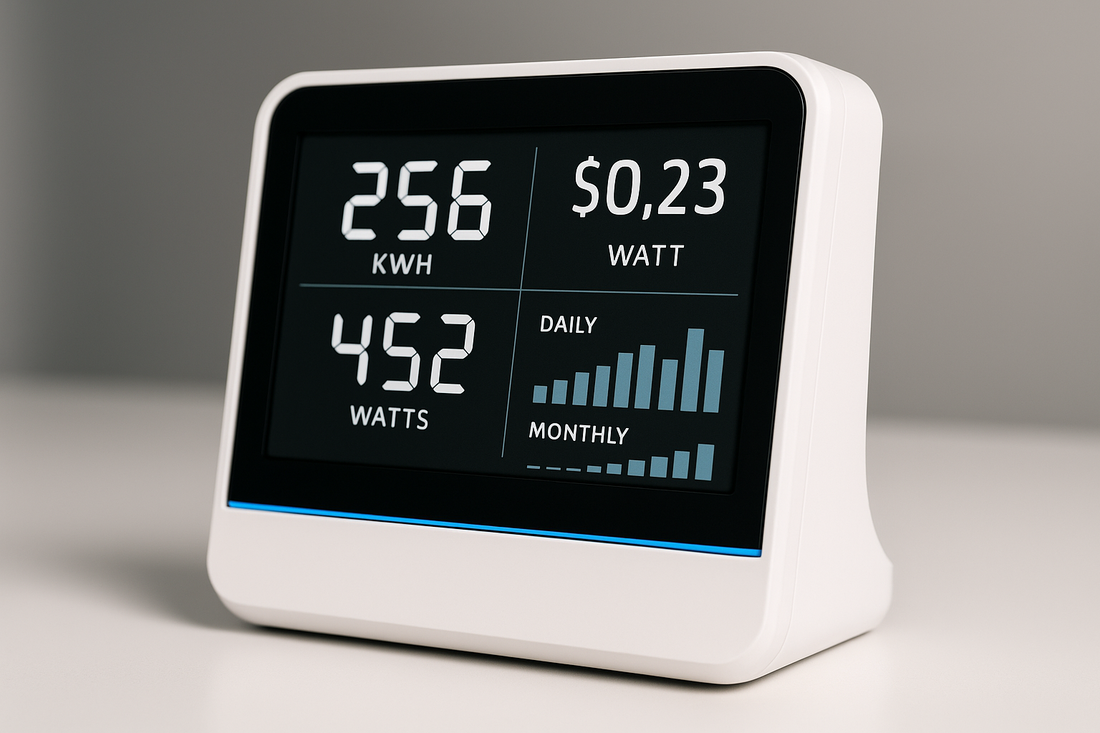
How Energy Monitors Help You Save Electricity at Home?
Share
An energy monitor can transform how you manage electricity in a smart home. In the first 100 words, we will explain clearly why this device matters and how it can help you solve real problems. By offering real‑time visibility into power usage, you empower smarter decisions—reducing waste, automating routines, and cutting costs in meaningful ways.
Understanding What an Energy Monitor Does

Real‑Time Electricity Tracking
An energy monitor measures voltage, current and power factor, then delivers real‑time data via Wi‑Fi or cloud dashboards. Unlike a utility meter that only provides monthly totals, this gives second‑by‑second insight into usage patterns.
Circuit‑Level vs Whole‑Home Monitoring
There are two main system types: sensors attached to individual circuits (or plug‑in smart plugs), and whole‑home clamp systems. Circuit tools let you monitor appliances like A/C, fridge, washer; whole‑home solutions show all power flows combined, often disaggregating major appliances over time.
Why Smart‑Home Users Benefit from an Energy Monitor
Identify “Vampire” or Standby Loads
Many devices draw standby power even when off. An energy monitor helps detect these phantom loads—often 1–15 W per device—and eliminate unnecessary usage.
Behavior‑Driven Savings
Studies show home energy use drops 4–15% once people have access to feedback. One review found average reductions of 6.5–11% with in‑home displays, and even aggregate feedback (without disaggregation) lowered usage by around 3‑4.5%.
Better Automation and Load Shifting
Smart‑home platforms can automate routines based on energy data: for example, delaying washing machine or EV charging until off‑peak hours. This can reduce your electricity costs further and smooth loads across the grid.
EdgeAnt’s Role in Smart‑Home Energy Monitoring

EdgeAnt Product Range & Key Features
EdgeAnt offers a variety of smart home energy monitor options—from single‑phase clamp meters with 80A or 120A sensors for apartments to models supporting up to 16 circuits or solar/net metering functionality. These devices deliver real‑time tracking, voltage/current/power‑factor analytics, and cloud dashboards compatible with platforms like Tuya for automation.
Why Choose EdgeAnt in a Smart‑Home Setup
EdgeAnt’s monitors integrate seamlessly with smart‑home platforms, so appliances, thermostats and plugs can react to energy data automatically. Their models support solar production tracking and bidirectional net metering, which is ideal for homes with rooftop panels. With ±2% sensor accuracy, they ensure reliable data for decision‑making.
Strategies to Save Electricity Using an Energy Monitor

Audit High‑Use Appliances First
Start by using circuit‑level sensors or smart plugs to identify heavy power users—such as older freezers, space heaters, or entertainment systems. Many users report cutting their electric bill by switching off or replacing just one energy hog.
Automate Smart Responses
Once usage patterns are identified, create automations: for example, turn off idle chargers at night, schedule washing machines during off‑peak periods, or close motorized shades when solar gain heats interior spaces excessively.
Integrate Solar & Net Metering
If your home uses solar panels, a smart monitor like EdgeAnt’s supports tracking both energy consumption and solar generation. This enables you to optimize self‑consumption and even sell surplus electricity back to the grid.
Choosing the Right Energy Monitor for Your Home
Step 1 – Clarify Your Goals
Decide whether you want to:
Audit specific appliances
Monitor solar performance
Automate device behavior
Track whole‑home usage
Your choice between plug‑in, circuit, or whole‑home systems depends on your needs.
Step 2 – Check Compatibility & Automation Support
Make sure the monitor works with your smart‑home platform (e.g. Tuya, Home Assistant, Alexa). EdgeAnt models are built for integration and ease of automation.
Step 3 – Consider Installation Safety
Whole‑home clamp sensors should be installed by a qualified electrician. EdgeAnt provides clear warnings and encourages professional installation for safety and accurate measurement.
Real‑World Impact: Examples and Case Studies
Evidence from Empirical Studies
In Ontario, Hydro One’s trial saw a 6.5% electricity reduction when users got energy monitors and in‑home displays. In Spain, a six‑month test showed consumption dropped over 11%, with monthly savings around 14%.
Smart‑Home User Experience
One community member on Reddit shared:
“Based on grid and socket monitoring I’ve reduced my energy bill from £200+ a month to a little over £100 ... switching to motion‑triggered lighting … setting fridge to 5℃…” .
These are achievable results when data‑driven behavior changes are implemented.
FAQ – Frequently Asked Questions
Q1: Can an energy monitor really save electricity?
A: Yes. By showing where energy is being wasted—especially standby loads or inefficient appliances—it empowers behavioral changes and automation that typically cut bills by 4–15%.
Q2: Is an energy monitor hard to install?
A: Plug‑in smart plugs are easy DIY. Whole‑home clamp meters must be installed safely—preferably by a licensed electrician.
Q3: Will it work with solar panels?
A: Many models (such as those from EdgeAnt) support bidirectional monitoring, enabling you to track both solar production and grid consumption.
Q4: How does it integrate with smart homes?
A: Once connected to platforms like Tuya or Home Assistant, the monitor can trigger automations—e.g. turn off devices at certain thresholds, shift loads, or manage thermostat settings.
Conclusion
A smart home energy monitor is much more than a gadget: it’s a tool for transforming your electricity usage into actionable insights. By combining real‑time energy tracking, appliance audits, smart automation, and even solar monitoring, you can significantly lower electricity bills while boosting sustainability. EdgeAnt’s product range offers reliable accuracy, solar‑ready measurement, and seamless integration into modern smart home ecosystems—making it a compelling choice for users who want real value, not just data. Use an energy monitor to make your home smarter, greener, and more efficient.